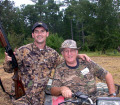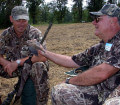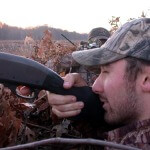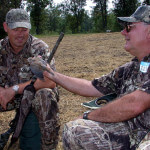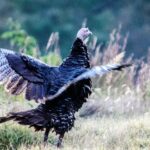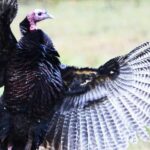John’s Note: One of life’s bummers is having to work on opening day of dove season. Your heart and your mind are in the field watching high-flying, shell-dodging, gray ghosts zoom over a cornfield while out-of-practice gunners try to calculate speed and distance and estimate an invisible point in the sky where lead will cut feathers. But these brief remembrances of a great dove shoot must be forced out of your mind to return to the world of work and deadlines. However, by brother is an expert at coming up with urban spots to hunt.
 On the opening day of dove season one year, my brother Archie and I drove out past the steel plants to the very edge of the city limits.
On the opening day of dove season one year, my brother Archie and I drove out past the steel plants to the very edge of the city limits.
Archie pulled into a driveway surrounded by a chain link fence. All I saw were acres of a red gravel rock called chert but no dove field. The area looked like a parking lot, and steel pipes stacked in rows covered almost the entire site. To the left of the driveway where we went in was a freshly mown grass field. A power line right-of-way was on the backside of the property, and below it flowed a small stream. The property we were to hunt was a place where pipe from Birmingham, Alabama’s steel mills was tested and stored for shipment by a subsidiary company. The area didn’t look anything like any dove field I’ve ever hunted before.
“Archie, have you lost your mind?” I said. “This spot isn’t a dove field! No way will we be able to hunt and take any doves here. As usual, little brother, you just don’t understand,” Archie explained. “I’ve been scouting these doves for several years. The man who owns this property is a friend of mine. When I asked him about the possibility of hunting here, he said his men weren’t working on Saturday, and we’d be welcome to hunt. The doves roost across the road in those big trees.
They get gravel for their craws from the rocks here. The grass field that’s just been cut is full of seeds the birds like to eat. The  creek on the backside of the property is where the doves water. The power lines provide a loafing site. You’ll always see doves on them. This spot is ideal for dove hunting. I’ve been hunting here the last couple of years. I get more shooting here and take more doves in this region than I do when I go to the farming sections of our state.
creek on the backside of the property is where the doves water. The power lines provide a loafing site. You’ll always see doves on them. This spot is ideal for dove hunting. I’ve been hunting here the last couple of years. I get more shooting here and take more doves in this region than I do when I go to the farming sections of our state.
“I particularly like this site because it’s handy. I can get off from work at 5:00 p.p., put on my camo clothes at the office, keep my guns and shells in my truck and still get an hour to 1-1/2 hours of shooting a day. I have several spots like this just on the outskirts of the city limits. Different plants and storage sites in our region have plenty of doves on them but little or no hunting pressure. Although some of these places have taken me a year or two to get permission to hunt, generally once I do obtain permission, I’m the only one hunting that particular group of doves.
Most people drive past some of the best dove-hunting sites in their area each day on their way to work. For years I’ve said, ‘I wish I could hunt that spot,’ and never have taken the time to find out what is required to get permission to hunt a place or check into the possibilities of being able to hunt these urban dove fields.
 Even though I’ve been turned down quite a few times, over the years, I’ve located about six industrial sites that I can hunt anytime I wish. Instead of having to plan for a weekend dove trip once or twice a year, I now can go dove hunting any afternoon the mood strikes me and in most instances have all the shooting I’ve ever dreamed on having.”
Even though I’ve been turned down quite a few times, over the years, I’ve located about six industrial sites that I can hunt anytime I wish. Instead of having to plan for a weekend dove trip once or twice a year, I now can go dove hunting any afternoon the mood strikes me and in most instances have all the shooting I’ve ever dreamed on having.”
My older brother made a lot of sense. Plenty of fields, gravel pits and industrial sites around Birmingham homed large populations of doves. I’d always dreamed of hunting these regions but assumed they were off-limits because they were situated so close to the city. However, after checking with my local conservation officer, I learned these areas could be hunted if the sportsmen had the landowner’s consent. You can pinpoint places close to the suburbs to hunt doves, if you’ll take the time.
Next: A GREAT URBAN DOVE HUNT

